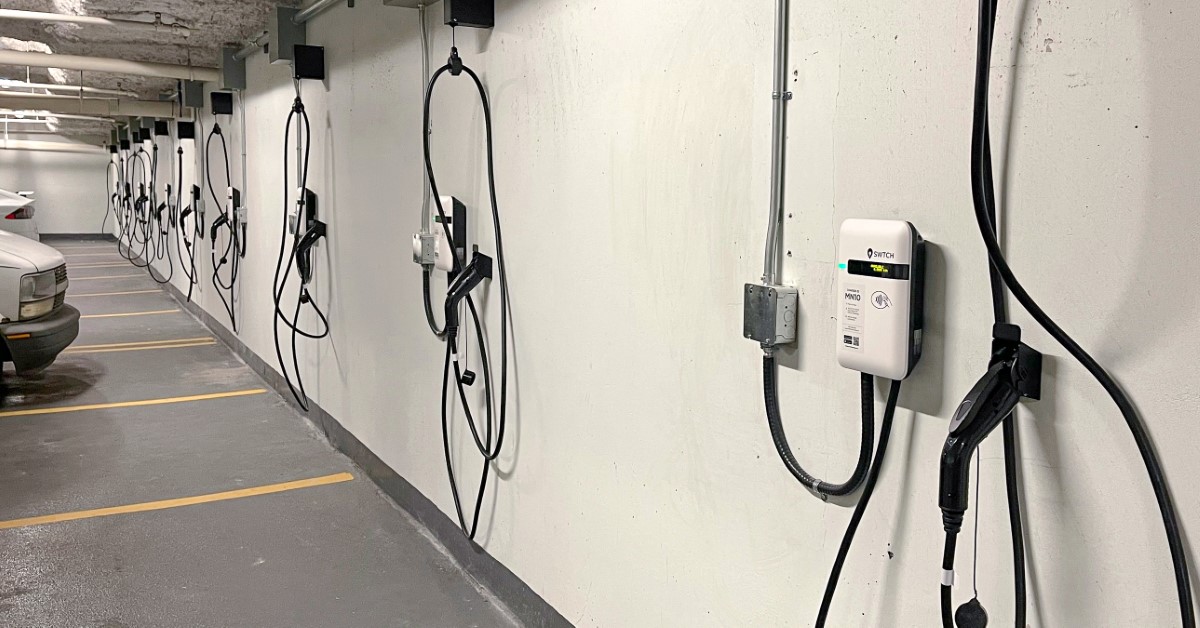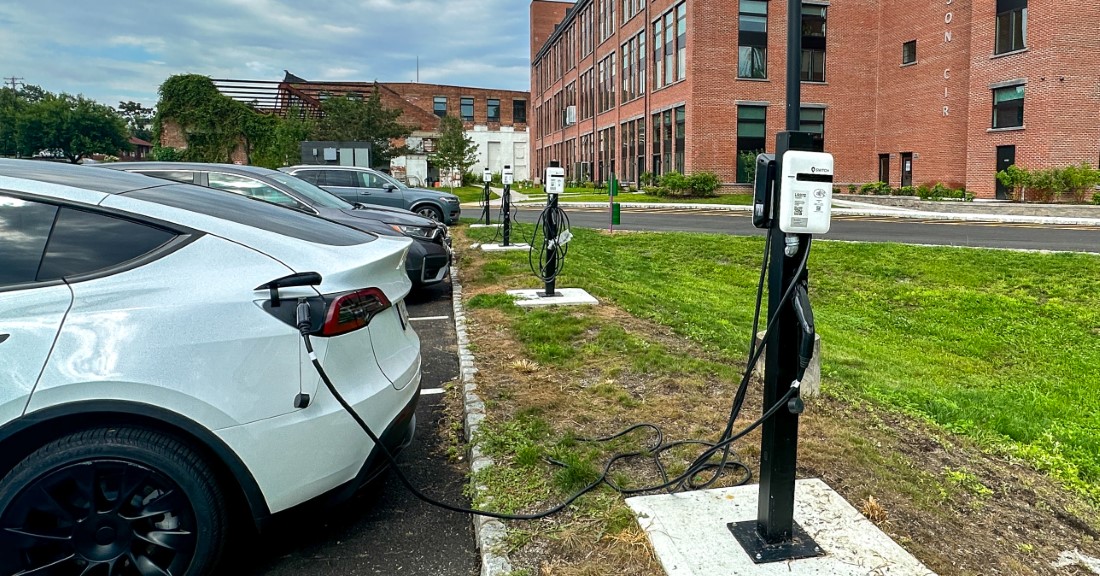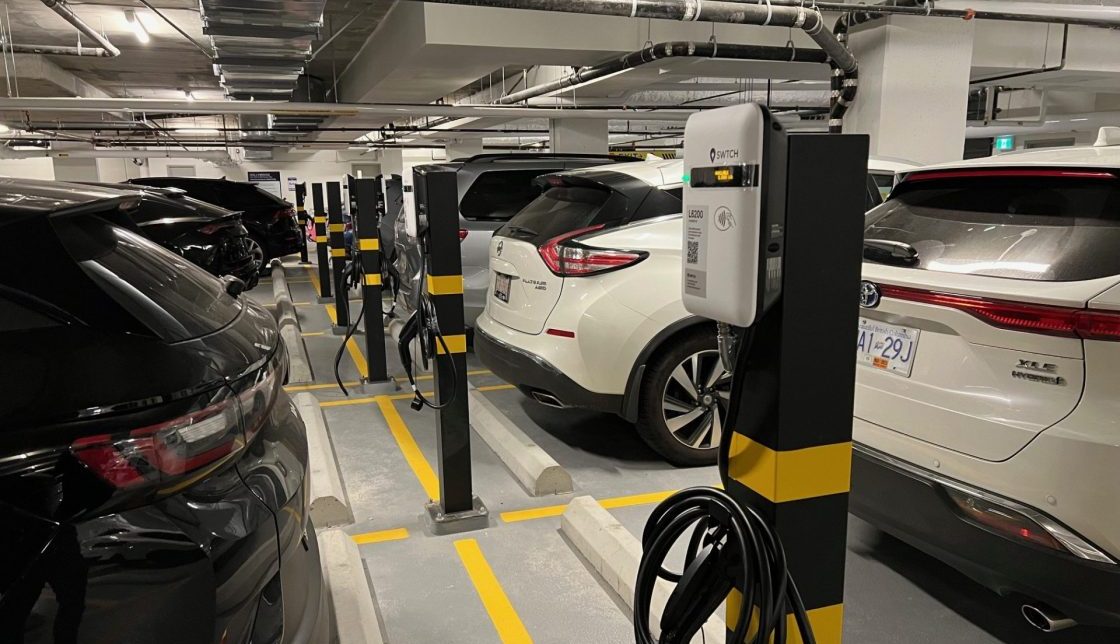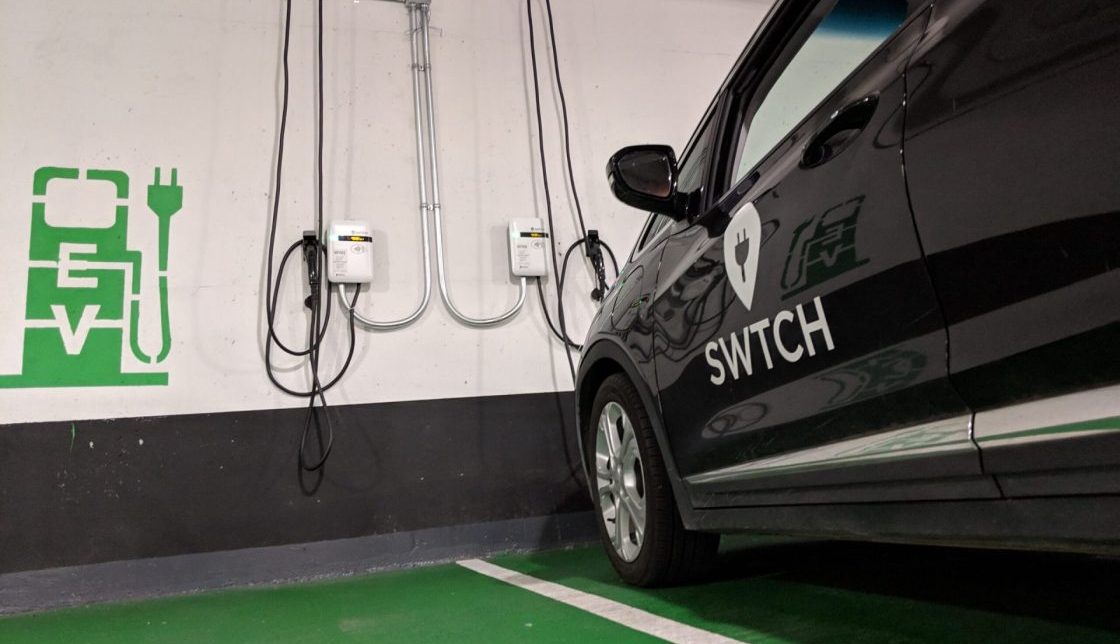How to install EV charging stations at every kind of building and property
Talk to the happiest EV drivers and, odds are, you’ll find they’ve got a great charging setup available to them—probably at home, possibly at the other places where they spend most of their time.
Whether you’re an EV driver yourself or you’re a property owner looking to make your location more friendly to EV drivers, this article will give you the info you need to get together a plan to install EV charging stations at your property.
Skip ahead to the right section for your property, and reach out if you ever have questions! Our team is happy to help.
Before you jump ahead, a primer on the kinds of EV charging stations that are out there
There are three general kinds of EV charging stations, and not all kinds are appropriate for all environments.
Level 1 charging stations: Slowest and cheapest
The equivalent to plugging a car into an electrical outlet. Charging a vehicle from empty to full will likely take multiple days.
Level 1 chargers can be enough for most drivers to get around with, but they’re not as convenient, and will likely require drivers to always have their cars plugged in.
You’ll generally find these in homes, and they’re better than nothing for workplace charging or other environments where people are plugged for many hours in a row, but they’re just generally not recommended.
Level 2 charging stations: Good charging speed, reasonable cost
Also called “destination chargers,” Level 2 chargers can charge a vehicle from empty to full over the course of hours – often overnight or over the course of a work day.
These are extremely practical, and arguably the best choices for most day-to-day charging. They’re not ideal for pit stops on long journeys, though.
You find these kinds of chargers everywhere, and though they do require special outlets, more electrical capacity, and professional installation, they’re going to be the best choice for most projects at most properties.

Level 3 charging stations (properly, DCFCs): Amazing speed, enormous cost
Probably the most visible kind of charging station out there, a level 3 charging station or DCFC can fully charge up most vehicles in anywhere from 15 minutes to just over an hour.
These are fantastic for use when driving long distances or in need of a fast boost to a car’s state of charge, but everything about them is more expensive—the cost to charge up, the cost of the hardware, the cost of the electrical upgrades.
And, it’s important to note, these charging stations can only go in specific environments. You will never find a DCFC charger at a single-family home or multifamily property.’
Installing EV charging for your single-family home
If you’re looking to install EV charging for your home, congratulations! Owning an EV is, in addition to all the benefits of sustainability and cost of ownership, a lot of fun!
Odds are, you’re going to want a Level 2 charging station for your home. This will provide you the best charging experience, and ensure you can pretty much always have a full battery without a ton of planning required.
Here’s everything else you’ll need to do.
Step 1: Before you do anything else, look at local requirements
We’ve got general guidance in the following sections that should help most people get a great charging setup at home, but before you get to any of that, please review your state or provincial guidelines for installing EV charging stations.
Odds are, you’re going to have some sort of incentive or rebate program available to you to help pay for the cost of purchasing and installing an EV charging station. It’s also likely that there will be additional requirements for things like:
- The charger hardware you can purchase
- Where you can purchase that hardware
- Who can install that hardware
- The process you must follow in order to receive your rebate
Following government guidelines here will net you the most benefit, so take any other information you read here as a bonus, but stick to what they ask of you to ensure you get the best value for your money.
Step 2: Get a sense of whether your home has capacity for a charger
The cost of installing an EV charging station can be quite reasonable if your home has spare electrical capacity. There will be a need to run cable from your panel to the desired location of the charging station, plus installation of the charging station itself, but all of this will likely fall into the range of a few hundred dollars to a little over a thousand dollars.
If your panel does not have capacity for an EV charging station, you’ll need to upgrade the panel. That can be quite expensive, likely costing thousands of dollars.
Whether you can get a sense yourself or want to get an electrician on the scene to verify, it’s a good idea to take stock of your current situation before making any moves. The last thing you want to do is purchase a new charging station that you can’t even use.
One more thing: This will also be a good time to verify whether there are specific requirements for your city pertaining to EV charging station installation. Take a look at your municipal website, just in case, and be sure to get any necessary permits.

Step 3: Pick out your charging station hardware
If there’s a fun bit to this process (aside from eventually having a charging station at your home), it’s the bit where you get to pick out which charging station you’re going to install. That’s this bit!
There are too many variables that can influence the best choice for your station, so we won’t get into all of them here or make specific recommendations. Here are a few basic pointers, though:
- Make sure your chosen charger (and configuration, if there are multiple for the same model) is compatible with your specific electrical setup (panel capacity, cable, plug, etc.)
- Make sure your chosen charger comes with the correct connector for your vehicle
- Don’t worry too much about “smart” features. They can be fun, but for most people, they wind up going unused before too long. Save some money and just get a reliable charging station.
Step 4: Find yourself an electrician to install the charging station
Here’s the good news: installing an EV charging station at a single-family home is not an especially difficult project for a good electrician. You should have little trouble finding someone suitable in your area to get the job done—and if you already have an electrician you like, you should feel comfortable reaching out to them to see if they’ll do the job and what their rate would be.
If you’re going to start hunting, though, here are some lists of electricians organized by state.
After the charging station is installed (generally, this kind of project should only take a few hours to complete), you should be all set to charge up quickly, whenever you like.
Enjoy!

Installing EV Charging for Multifamily Homes (Apartments and Condos)
Installing EV charging stations tends to get a little trickier with apartments and condos than with single-family homes because usually there’s a separate property owner or condo association you’ll have to get on board with your project.
Additionally, the work associated with completing electrical upgrades for these kinds of buildings tends to be more expensive, and usually, the desire will be to complete upgrades for more than just one driver at a time.
Here’s what’s most critical to get right:
Understand the funding options for multifamily charging
Electrical upgrades for multifamily properties can be quite expensive, and most buildings will require them when installing EV charging. There is, however, money out there, so be sure to secure as much state, federal, or provincial funding for your project as possible—it could make tens or even hundreds of thousands of dollars of difference.
Choose a charging solution built for multifamily buildings
Not all EV charging solutions are equally good for multifamily properties. Solutions with load management, like SWTCH, let you run more charging stations with fewer or less expensive electrical upgrades, and help ensure you avoid excess demand charges for whole-building consumption. It’s a huge asset for multifamily properties, and a must-have in your solution.

Find a great EV charging installation partner
Unlike installations for a single-family home, multifamily EV charging shouldn’t be installed by just any electrician or contractor. Experience matters a great deal and can help you avoid common mistakes that can make a charging setup more expensive to install, less safe, or less easily upgradable down the line.
Determine the best place for your chargers
The ideal positioning of charging stations can depend on a lot of factors, including proximity to entrances, elevators, and your electrical panel. You’ll want to work with both your installation partner and your solutions provider to find the best possible location for maximum convenience and functionality at the lowest cost.
Plan for expansion of your installed chargers right away
It’s almost certain that your property’s EV charging needs will increase in just a few years. You don’t need to buy charging stations for future demand, but you’ll likely save on your electrical upgrades if you go ahead and install more capacity than you need today, so it’s worth including that in your plans if your budget allows. Aside from saving you money, this approach also means that as soon as there’s enough need, you can install your new charging stations without delay.
Multifamily EV charging solutions are our specialty here at SWTCH, and we put together an entire article detailing everything you need to know about installing EV charging solutions for your building. You can read that here.
If you have any questions that aren’t answered in the guide, let us know! We’ll be happy to chat.
Multifamily EV charging case study: The Lofts at Beacon Future-Proofed their Building with a Scalable EV Charging System

Installing EV charging for commercial, institutional, and other non-residential properties
Commercial properties encompass a wide range of buildings—everything from office buildings to retail centers and hospitality businesses. That means the particulars of getting EV charging stations for a commercial property are somewhat dependent on the specific property.
Before we get to the installation advice, here are some recommendations for the kinds of chargers to install in each environment.
Workplaces: Generally best served by Level 2 chargers, as workers are probably going to spend several hours without needing use of their cars. You’ll also be able to fit more charging stations into the budget by sticking to Level 2 charging stations instead of purchasing a DCFC, which can be tens or hundreds of thousands of dollars for just one unit.
Retail locations: Level 2 charging stations are great for these environments as well, and can encourage quite a long dwell time (especially appropriate if you have movie theaters or popular restaurants on location). Having a DCFC onsite, though, can also be a great move. People travelling long distances, or who just want to get a big boost to their state of charge very quickly, could well seek your location out. For the 30+ minutes they’re likely to be onsite, odds are good that they’ll pop into the local shops and make a purchase.
Hospitality businesses: Generally, hospitality businesses will also likely be best served by Level 2 charging stations; people are likely looking to plug in overnight while at the hotel, or to plug in for a couple of hours while dining at a restaurant. Could you install a DCFC? Possibly, though again, the cost of doing so is extremely high, and there are complications that can arise; does a hotel guest want to leave their room to move their car when it’s done charging?
Educational Institutions: Level 2 charging stations are ideal for educational settings. Students, faculty, and staff typically park for extended periods, making Level 2 charging speeds great for getting a nice boost to the battery. Consider placing chargers in student, faculty, and public parking areas so that all potential drivers are covered. For larger universities, a single DCFC in a central location could also be welcome, but this does introduce significant additional expense.
Hospitals: Healthcare facilities benefit most from Level 2 chargers, given that most people will be at the hospital for fairly significant lengths of time. For visitor parking, at least one DCFC would also likely be appreciated by some visitors who might have busy back-and-forth travel schedules to visit a loved one in the hospital and need a quick way to charge up.
No matter the kind of property, similar guidance for installation applies. Here’s what you should do.
Investigate the funding available for your property’s charging infrastructure
Ensure you seek out and secure as much funding as possible at the state, federal, or provincial level. This can save tens or hundreds of thousands of dollars on the cost of installing EV charging stations.
Select a smart EV charging solution that makes your charging stations easier to manage
Select a solution with load management technology to reduce the need for electrical upgrades and lessen the odds of incurring excess electrical demand charges.
You should also make sure you choose a networked solution with remote management and monitoring capabilities. This will allow you to accurately review and report on charger usage and make better decisions about how to evolve your charger offering.

Consider your charging monetization strategy carefully
Do you want your charging stations to be revenue neutral? Do you want them to pay themselves down quickly and start earning a profit? Do you want to offer free charging sessions as a means of improving customer, tenant, or employee satisfaction?
There are many options you can explore when deciding how or if to charge users for access to your charging stations.
Partner with installers who have experience with EV charging
Commercial property upgrades can be quite expensive, so don’t entrust this type of job to a team that doesn’t have deep experience in installing EV charging stations. The last thing you want is an expensive mistake.
Choose the right locations for your charging stations
Generally, places near entrances are considered ideal, but it’s important to take into account the proximity to electrical infrastructure, as well as that all spaces reserved for charging meet ADA requirements for accessibility.
Think long-term when installing the EV chargers you need today
Install the chargers you need today, but consider completing preparatory work for additional chargers while you’re at it. It will likely save you money in the long run and, when you’re ready to add more chargers, the job will be very quick and easy.
To learn more about EV charging for commercial properties, check out our complete guide here.
And be sure to read this customer spotlight: Fairmont Royal York Integrates EV Chargers to Meet Guest Demand and Advance Sustainability Mission

Securing funding through incentive and rebate programs for EV charging
Particularly for larger projects across multifamily, commercial, or institutional properties, securing funding is a game-changer when it comes to putting the cost of installing charging stations within reach.
It’s well worth the effort to look through the options available in your area and to apply to as many programs as your project applies for. Depending on what your property qualifies for, the incentive or rebate money could drag the cost of your project down to as low as near zero.
There will typically be a fair amount of paperwork involved in applying for these kinds of programs, so be prepared to either have a member of your team dedicate a fair amount of time to completing the work, or else consider partnering with a solutions provider that offers assistance. SWTCH, incidentally, can complete applications for some popular programs, offer guidance for others, and even provide accelerated funding to get you funded—and started—faster. Reach out to our team today if you’re interested in learning more.
Your chargers are installed—What’s next?
It’s important to remember that installing EV charging is, in a sense, the beginning. Once chargers are operational, it’s important that they remain that way to ensure that users are able to have the charging experience that they want and to enable future enhancements to meet the evolving needs of EV drivers who frequent your property.
Note that for single-family homes, most of these items do not apply. They are, instead, intended for individuals overseeing EV charging for multifamily, commercial, or institutional properties.
Maintenance and troubleshooting basics
Generally, you should plan for at least an annual inspection of your charging stations to make sure they are functioning correctly. You should also look to partner with a solution provider that offers 24/7 monitoring, as that will ensure you get immediate alerts in the unlikely event that something goes wrong. With any luck, the issue will even be resolvable remotely, allowing your solutions partner to remedy the outage without any input from you.
Monitoring and optimizing usage of your EV chargers
Once chargers are in the ground, it’s important to take a look at usage data to understand:
- Which chargers get used the most
- When chargers get used the most
- How long typical charging sessions are at your property
- How many different drivers make use of your chargers
- How much energy is consumed by your chargers
- How much revenue your chargers make
- And whatever else your EV charging management solution can tell you
All these data points can help you understand whether your chargers are meeting original expectations or desired outcomes that led to their installation and also to gauge when your charging offering is in need of expansion.
Think you’ll want a hand digging through the data? It’s a good idea to partner with an EV solutions provider with a strong customer success team who will be there to guide you whenever you need it. Be sure to make that a part of your evaluation criteria when selecting a partner.

Keep track of the benefits that your chargers have delivered you
Calculating ROI with EV charging can be as simple as comparing incoming revenue from charging sessions vs the cost of installation, hardware, software, and maintenance over the course of years, but this almost definitely will undervalue the impact.
Try to also account for less direct benefits: tenant, customer, or guest satisfaction; improved retention, win-backs for lost tenants who returned once EV charging was available—whatever it is your organization is trying to accomplish by installing EV charging, try to capture the impact made by getting chargers installed.
It’s worthwhile from a business perspective, just to see if further investment is warranted, but it’s also worthwhile from a storytelling perspective as well. EV charging is a great investment in sustainability, and any wins you experience are worth celebrating and sharing with the world.

Following our guidelines will make it easier to take the right steps to get a great charging experience installed for your home, office building, or anywhere else. There is, of course, more to it than we’ve had a chance to discuss here, so if you have detailed questions or want to know how SWTCH can help you bring your EV charging project to life, please let us know! We’ll be happy to help.






